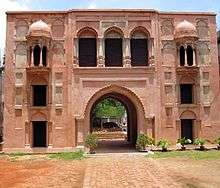Nimtali Kuthi

Nimtali Kuthi or Nimtali Palace was built towards the end of the Mughal rule in Dhaka as a residence of the Naib-Nazim (Deputy-Governor) of Dhaka Province in 1765-66. It was situated in the Nimtali ward and popularly called the Nimtali Kuthi (Nimtali Palace). All have disappeared over time, but only one gateway (Nimtali Deuri) of the palace still remains.[1] It is the first colonial Building in Dhaka, Bangladesh.
History
When the capital of the Subah-i-Bangla was shifted from Dhaka to Murshidabad in about 1717, Dhaka was made the seat of a Naib Nazim (Deputy-Governor of a sub-province) comprising the greater part of present Bangladesh.
The Naib-Nazim, Nawab Jasarat Khan, resided in one of the many abandoned Mughal palaces or Forts. In 1763, as a reprisal after Nawab Siraj-ud-Dowla’s attack on Calcutta, the British Army officer Lt. Swinton stormed into Dhaka and occupied the 'fort' as his residence. The naib-nazim (Jasrat Khan) who lived in the main fort in Dhaka (the present central jail) was not in Dhaka, and he was taken as a prisoner by Mir Qasim for his secret liaison with the British.
In 1765, Lord Clive re-appointed Jasarat Khan as the Naib-Nazim of Dhaka. He found his residence occupied so he stayed in the Bara Katra, another old palace of the Mughals. Swinton built a new residence at Nimtali hastily and completed by 1766—the first noted building built during the Colonial Period in Dhaka.[2]
Nimtali Deuri was part of the socio-religious life of the Dhakaites. Early nineteenth century paintings, now at the National Museum, depict that the Eid processions used to originate and terminate at the Nimtali Deuri. Another significant event was the flag music, played from the Deuri gallery.
The Nimtali Palace remained the official residence of the naib-nazims till 1843. With the consolidation of power of the East India Company, the naib-nazims gradually lost all military and administrative functions as well as authority. They were officially stripped off their power in 1822.
The last of the naib-nazims, Nawab Gaziuddin, who lived there, frittered away all the wealth that the family possessed and lived a very extravagant life and died in 1843. From then on the ownership of the palace changed several hands and most of it was demolished. Thus the Palace of the naib-nazims of Dhaka and the surrounding lands, after passing through various vicissitudes and owners; in the early part of the 20th century, when the new capital and University of Dhaka were being built, the Government acquired the entire Nimtali area. The sole surviving gateway, now lies within the compound of the Asiatic Society as the only witness to testify the existence of the Nimtali Palace.
Description
Nimtali Palace occupied a considerable area on the northern side of the city between the modern Nimtali Mahalla and the High Court building and consisted of a number of separate buildings. The site was just at the periphery of the city, mostly surrounded by woodlands. No detailed or correct description of the place could be given as no contemporary narrative or plan was found. However, it is assumed, judging from the only existent gateway, the Nimtali Deuri that it was built after the usual Mughal palace designs with several gateways, inner court, private residences, and place of prayer, tanks or water reservoirs, barracks for soldiers and quarters of staff, gardens and the like.
A narrow water channel running from the north and drawing water from the Kamalapur River in the east formed the water supply system of the palace. There was also a large tank called Nawabi Dighi (which still survives and can be located in between the Fazlul Haque Hall and Shahidullah Hall of Dhaka University) and the Nawabi Masjid or mosque, a single domed structure to the south of the present Asiatic Society complex.
Bishop Heber who visited the city in 1824 left a graphic description of the palace complex although most of it was then in ruins. He mentions a “really handsome gateway (Nimtali Palace), with an open gallery, where the ‘Nobut’, or evening martial music, is performed, a mark of sovereign dignity, to which the Nawab never had a just claim, but in which Government continued to indulge him". He further mentions, “A very handsome hall, an octagon, supported by gothic arches, with a verandah round it, and with high gothic windows.”
In addition to what has been mentioned by Heber, there was one chamber with twelve doors known as ‘Baraduari’. It is said that the chamber was earmarked for the audience of the twelve Sardars (leaders) of mahallas of the city, who at the time of the audience used to enter the hall individually through the twelve doors. This audience hall which once housed the Dhaka museum from about 1914 to 1983 is now a part of the teachers’ residential quarters of the Dhaka University, Anwar Pasha Bhaban.
As long as the palace remained the residence of the naib-nazim, it played many significant roles in the social and cultural life of Dhaka. It acted as the upholder of the Mughal culture in Dhaka patronizing classical music and dance, painting and other arts and crafts. One colorful event that took place there regularly was the Eid procession brought out in celebration of the Eid-ul-Fitr, which started and ended at Nimtali Deuri after parading different parts of the city.
Etymology
The origin of this word could not be found, but it is assumed that the place was once full of neem trees.
References
- ↑ Ahmed, Sharif Uddin (2012). "Nimtali Palace". In Islam, Sirajul; Jamal, Ahmed A. Banglapedia: National Encyclopedia of Bangladesh (Second ed.). Asiatic Society of Bangladesh.
- ↑ Khan, Waqar A (18 January 2013). "The Nimtali Deohri". Star Weekend. The Daily Star.